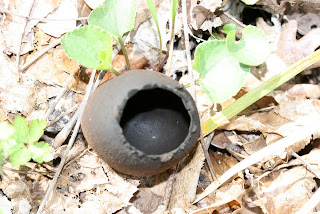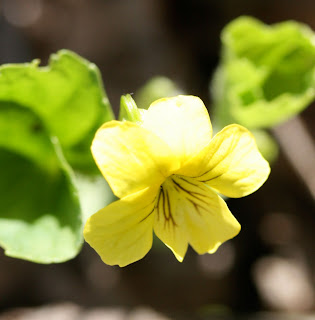Nate Meets Nonna and Poppa's New Digs
Every day for one-hundred days, the drama and delights of living in the boonies.
Sunday, May 29, 2011
Sunday, May 15, 2011
THE BIGGEST, BADDEST LESSON OF ALL
Letting go
Buddha has been whispering in my ear––attachment, appeasement, illusion, longing.
I m p e r m a n e n c e . . . . remember?
The cutesy note card on my desk tells me to pull up my big-girl panties and get over it.
Even the bullfrog chorus is singing an old Blow Monkeys hit, You Don’t Own Me.
Truth is, though, I’m not really feeling all that Buddhisty about leaving this place.
I know, I know, I really do know.
It’s not mine. It never was.
I was lucky to be here for a little while.
I was lucky to be here for a little while.
No matter how good, when it’s over, it’s over.
It’s always going to be a part of me.
 |
| Things and ideas are as ephemeral as a dragonfly shadow. I guess . . . . . |
 |
| Simple gifts duly noticed |
There is considerable comfort in knowing I soaked it all up, never took one minute for granted.
And as advised, I have not avoided the pain of letting go; just schlepped right through it.
A million good reasons to stay~~
 |
Thanks for blogging with me these past 100 days!
For some absolutely irritating advice on letting go:
http://www.livinglifefully.com/lettinggo.htm
You Don’t Own Me sung by the Blow Monkeys:
Saturday, May 14, 2011
COUNTRY SCHOOL
 |
| Surface-layer dweller Didn't make the cut |
I also think what on earth possessed me back in February to casually commit to a hundred days of writing? I did not get out the old abacus and figure out that a hundred days would end halfway through the month of May. Such a commitment is not like having a monkey on your back; it’s more like having King Kong, J. Fred Muggs, and the entire the fleet of bonobos from the Great Ape Trust in Des Moines on your back. But good. . . . .
Monkeys and all, I now have a diary of my time in the wilds of Ioway. Thank you to all who have shared in this reminiscence.
I finish with two days of lessons learned in “country school” over the past 16 years. Most of them are pretty portable, not at all confined to the countryside or even the out of doors.
Approach slowly. When you rush in, things skedaddle, and you may never even know what you've missed.
 On a camera, you roll focus from a close up to a telescopic or wide shot. The full landscape is breathtaking. The fine hairs on moss are equally delightful.
On a camera, you roll focus from a close up to a telescopic or wide shot. The full landscape is breathtaking. The fine hairs on moss are equally delightful. Lesson Three ~ Pay attention
Being there is not about location, location, location. It’s about allowing your senses to do their thing and then noticing what they bring to you.
Lesson Four ~ Know your prejudices
Know what grabs your attention. Things that move attract us; check also for things that are still. Colorful things attract us; appreciate the neutral tones. Size gets our attention, whether huge or microscopic. It’s easy to miss the middles.
Lesson Four ~ Leave your preconceptions at the door
What you’ve always believed can blind you. I always thought algae was disgusting and a sign that something was amiss in a pond. Turns out algae is very interesting and beautiful. And, it’s vital to life. To quote my firstborn, “Mom, algae coming and going means your pond is alive. If there’s no algae, it’s like a dead swimming pool.”
Lesson Five ~ Appreciate
What seems common or mundane is likely miraculous on further reflection. Just because I've seen the mother sparrow fly out of the cow's eye a thousand times doesn't mean I don't appreciate it.
And it’s okay to express appreciation even if it’s not understood. I have thanked a turtle for letting me put a hand on her shell, all hot from the sun. Didn’t do much for her, but I felt fine.
Lesson Six ~ Luck
There is such a thing as random, coincidental, accidental, arbitrary good luck. Some things are not earned, not deserved, not owed, not planned for nor cleverly arranged. They just happen, and you are there to reap the benefits. Accept your good luck.
Lesson Seven ~ Receiving gifts
Lesson Eight ~ Waiting
Patience may or may not be a virtue, but it pays off in the woods and on the water. If you wait, more often than not, something worthwhile will occur. Let things come to you when they are ready.
Lesson Nine ~ Nature ain’t always nice
Nature can be unkind, even unnecessarily cruel. Okay, hawks have to eat, too, so they kill rabbits. Why must they do it so violently? How does that improve the system? And things don’t always work out for the best. Mothers abandon babies, fathers may dine on them even when there are other options. Nature isn’t necessarily right or wrong, good or evil. It just is.
Lesson Ten ~ Back off
Don’t be too compulsive. Everything’s not ruined if you don’t catch sight of every single kind of woodpecker or warbler. Life will go on if you missed one day out of thirty days the herons were on the pond. Once can be enough. (But, damn! I would love to see that pileated again…)
Some days there’s a good view, some not so much. Move on.
Lesson Eleven ~ Impact
No matter how quiet and soft of foot, we make an impact.
Lesson Twelve ~ You’re not the boss of nature
Instinct and experience tell many wild critters we are hell bent on harming them. Our intentions do not matter. Our good acts do not count. Critters decide who their friends are, and we likely aren’t on the short list. We’re all just another hunter to a deer.
Lesson Thirteen ~ Sit still
Amazing things happen when you learn to sit still for hours. Sometimes we begin to recognize the amazing in the mundane when we sit. Sometimes the amazing actually happens.
If it’s valuable, it takes time. It’s not easy to sit in a kayak in the shallows for four hours. The rewards are worth the leg spasms and bug bites.
 |
| Tree defies death by beaver |
Lesson Fifteen
Life is not easily discouraged.
Lesson Sixteen ~ Tolerance can be improved.
I am not fond of feeling a spider crawl up inside my pant leg. This is especially true when I'm wearing shorts. But if the Great Blue Heron hasn't caught wind of me, I won't risk scaring her off by dispatching an arachnid. I can take it.
Tomorrow: The biggest, baddest, hardest lesson of all. . . . .
Friday, May 13, 2011
MY, OH MY, OH MYCOLOGY!
Lydia Gilbert, a distant great-grandmoher, was hung as a witch in the Salem Witch trials. Ann Putnam, great-grandmother x7, was the one who started the accusations of witches. My paternal grandmother ran off with the hired man in the 1940s, long before that sort of thing was popular. A few generations back, a cousin brought down the Jackson, Michigan banks with a slight accounting error and some lame attempts to cover that up. It’s really quite a diverse collection of relatives, don’t you think?
I suppose everyone’s family tree has memorable characters, but few can rival the stunning variety displayed by the fungus family. A Fungal Family Reunion includes mushrooms, mosses, molds, rusts, mildews, yeasts, and smuts. (Oh, come on, admit it-your family has some smutty members, too.) In fact, the fungus family is not really a family at all, taxonomically speaking; it’s an actual Kingdom, parallel to Plants and Animals. It includes 200,000 species. You can include Lichens, too, because they have such an intimate, symbiotic relationship with fungi. Hey, everyone has a symbiotic uncle hiding somewhere in the family branches.
Our woods is overflowing with fungi of every shape: round, cup, shelf, coral, spindly. And every color: yellow, orange, read, gray, white, pink, and black. Some are firm, some squishy and wet. All of them are releasing spores aplenty.
To underscore their amazing diversity, consider that different kinds of fungi are:
Delicious sautéed on your rib-eye
Poisonous
Poisonous
Injected into you to save you from infections
Good at controlling insects
Able to destroy the loaf of bread you just got from the health food store for $6 a loaf
Likely creating that unbearable itching between your toes
Breaking down plant materials to feed other plants and trees
Making you sneeze your brains out
Controlling erosion
Destroying entire crops
Being rooted out by hogs and dogs in France so they can be served in fine restaurants, probably by waiters who have jock itch caused by another fungus altogether
A Fungal Gallery
 |
| Black Jelly Drops? |
 |
| Coral Fungus |
 |
| Devil's Urn? |
 |
| Don't know its name, but I'd call it Old Woman's Hiney. Which is why they don't let me name fungi. |

 |
| Giant Puffball |
 |
| Crustlike Cup |
 |
| Bird's Nest Fungi |
 |
| Pigs' Ears |
 |
| Scarlet Cup |
 |
| Stinkhorn Very well named, too! |
 |
| And - Tonight's Dinner! Tomorrow and Sunday--the last two new postings for the Iowa County Almanac, #99 and 100. It will remain on line for a while, however. |
Thursday, May 12, 2011
WILDFLOWERS REVEALED
(from yesterday's post)
(from yesterday's post)
 |
| Virginia Bluebells (not my fault-I didn't name them) |
 |
| Virginia Bluebells |
 |
| Bluebell buds |
 |
| Yellow Sweet Clover |
 |
| Bloodroot |
 |
| Bloodroot |
 |
| Blue Vervain |
 |
| Chicory |
 |
| Wild Columbine |
 |
| Daisy |
 |
| Dutchman's Breeches |
 |
| Buttercup |
 |
| Dutchman's Breeches |
 |
| Forkleaf Toothwort |
 |
| Arrowhead aka Duck Potato |
 |
| Jack-in-the-Pulpit |
 |
| Jack-in-the-Pulpit |
 |
| May Apple |
 |
| May Apple Blossom |
 |
| Wild Geranium |
 |
| Wild Geranium |
 |
| Wild Geranium |
 |
| Lobelia |
 |
| Waterleaf |
 |
| Wild Orchis |
 |
| Phlox |
 |
| Phlox |
 |
| Wood Anemone |
 |
| Rue Anemone |
 |
| Spring Beauties |
 |
| Spring Beauties |
 |
| Spring Beauties |
 |
| Canada Thistle |
 |
| Turk's Cap Lily |
 |
| Turk's Cap Lily |
 |
| Yellow Violet |
 |
| Violets |
 |
| Violet |
 |
| Clover |
 |
| Common Wintercress |
 |
| Multiflora Rose |
 |
| Wild Rose |
 |
| Bellwort |
 |
| Gooseberry Blossoms |
Now, can you help identify these?
 |
| Aster? What kind? |
 |
| Not really a harebell. . . . |
If you know what these are, please identify them in the comment section.
Subscribe to:
Comments (Atom)





































